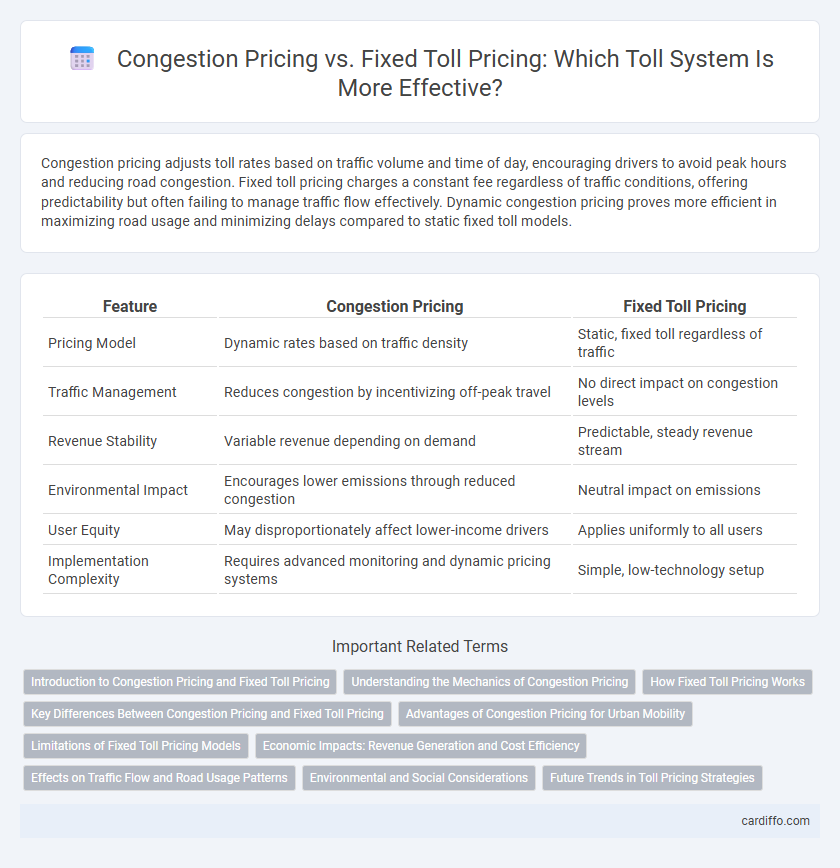Congestion pricing adjusts toll rates based on traffic volume and time of day, encouraging drivers to avoid peak hours and reducing road congestion. Fixed toll pricing charges a constant fee regardless of traffic conditions, offering predictability but often failing to manage traffic flow effectively. Dynamic congestion pricing proves more efficient in maximizing road usage and minimizing delays compared to static fixed toll models.
Table of Comparison
| Feature | Congestion Pricing | Fixed Toll Pricing |
|---|---|---|
| Pricing Model | Dynamic rates based on traffic density | Static, fixed toll regardless of traffic |
| Traffic Management | Reduces congestion by incentivizing off-peak travel | No direct impact on congestion levels |
| Revenue Stability | Variable revenue depending on demand | Predictable, steady revenue stream |
| Environmental Impact | Encourages lower emissions through reduced congestion | Neutral impact on emissions |
| User Equity | May disproportionately affect lower-income drivers | Applies uniformly to all users |
| Implementation Complexity | Requires advanced monitoring and dynamic pricing systems | Simple, low-technology setup |
Introduction to Congestion Pricing and Fixed Toll Pricing
Congestion pricing charges drivers variable tolls based on traffic demand, reducing peak-hour congestion and managing road capacity efficiently. Fixed toll pricing applies a constant fee regardless of traffic conditions, offering simplicity but potentially leading to increased congestion during high-demand periods. Understanding these models is essential for developing equitable and efficient transportation funding strategies.
Understanding the Mechanics of Congestion Pricing
Congestion pricing adjusts toll rates based on real-time traffic demand, effectively managing road usage by incentivizing off-peak travel and reducing traffic delays. This dynamic pricing model relies on data analytics and sensor inputs to optimize roadway capacity and minimize congestion. In contrast, fixed toll pricing charges a constant rate regardless of traffic volumes, potentially leading to inefficient road utilization and increased peak-time congestion.
How Fixed Toll Pricing Works
Fixed toll pricing sets a predetermined, unchanging fee for road usage regardless of traffic conditions, ensuring predictable costs for drivers. This system simplifies toll collection by applying a constant rate, often based on vehicle type or distance traveled, without considering congestion levels. Fixed tolls can lead to consistent revenue generation but may fail to manage traffic demand effectively during peak hours.
Key Differences Between Congestion Pricing and Fixed Toll Pricing
Congestion pricing dynamically adjusts toll rates based on real-time traffic conditions, aiming to reduce congestion by incentivizing off-peak travel, while fixed toll pricing charges a constant fee regardless of traffic flow. Congestion pricing optimizes road usage efficiency and manages demand, whereas fixed toll pricing provides predictable revenue but does not influence driver behavior or traffic patterns. The flexibility of congestion pricing supports smarter urban transportation management, contrasting with the static nature of fixed toll systems.
Advantages of Congestion Pricing for Urban Mobility
Congestion pricing dynamically adjusts toll rates based on traffic demand, effectively reducing peak-hour congestion and enhancing traffic flow in urban areas. This system encourages the use of alternative transportation modes and off-peak travel, leading to lower emissions and improved air quality. Cities implementing congestion pricing report increased public transit ridership and more efficient road network utilization compared to fixed toll pricing models.
Limitations of Fixed Toll Pricing Models
Fixed toll pricing models often fail to account for real-time traffic fluctuations, leading to inefficient congestion management and underutilized road capacity during off-peak hours. This static approach lacks the flexibility to incentivize drivers to adjust travel times or routes, resulting in persistent bottlenecks. Consequently, fixed tolls may contribute to increased delays and reduced overall network performance compared to dynamic congestion pricing systems.
Economic Impacts: Revenue Generation and Cost Efficiency
Congestion pricing maximizes revenue generation by dynamically adjusting toll rates based on real-time traffic demand, leading to more efficient resource allocation and reduced congestion costs. Fixed toll pricing provides predictable income but often fails to reflect traffic variability, resulting in underutilized capacity during off-peak hours and increased delays during rush periods. Implementing congestion pricing can improve overall cost efficiency by optimizing roadway usage and reducing time lost to traffic congestion, thereby enhancing economic productivity.
Effects on Traffic Flow and Road Usage Patterns
Congestion pricing adjusts toll rates based on real-time traffic conditions, effectively reducing peak-hour traffic by encouraging drivers to travel during off-peak times or use alternative routes, which optimizes road capacity and lowers overall congestion. Fixed toll pricing maintains consistent fees regardless of traffic volume, often resulting in predictable but potentially inefficient road usage, with peak periods experiencing heavy congestion and off-peak times underutilized. Studies show congestion pricing improves traffic flow by smoothing demand spikes and redistributing road usage patterns, enhancing travel time reliability and reducing emissions compared to fixed toll regimes.
Environmental and Social Considerations
Congestion pricing reduces traffic emissions by encouraging off-peak travel and lowering vehicle idling times, leading to improved air quality and decreased greenhouse gas emissions. Fixed toll pricing lacks flexibility and does not incentivize drivers to alter travel behavior, potentially resulting in persistent congestion and higher pollution levels. Socially, congestion pricing promotes equitable road usage by prioritizing efficient traffic flow and can fund public transit improvements, while fixed tolls may disproportionately impact low-income commuters who cannot adjust their travel times.
Future Trends in Toll Pricing Strategies
Future trends in toll pricing strategies emphasize dynamic congestion pricing to manage traffic flow and reduce urban gridlock effectively. Advanced technologies like AI-driven sensors and real-time data analytics enable adaptive toll rates that fluctuate based on demand, encouraging off-peak travel and optimizing road capacity. Fixed toll pricing faces challenges due to its inflexibility, while congestion pricing models are gaining traction for promoting sustainable transportation and revenue efficiency.
Congestion Pricing vs Fixed Toll Pricing Infographic

 cardiffo.com
cardiffo.com